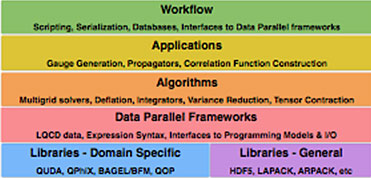Computer Science and Mathematics Projects
Exascale Application Development for Lattice Quantum Chromodynamics
99% of the mass of the visible matter in the universe comes from the fundamental interactions between the sub-atomic particles called gluons and quarks. The mathematical description of these fundamental interactions, Quantum Chromodynamics (QCD), has been successful at interpreting many high-precision particle collider data, but the rigorous non-perturbative calculations of QCD can only be done by putting it on a discrete 4-dimensional space-time grid, which is then spread over many, often hundreds or thousands of, compute nodes on the state-of-the-art supercomputers. This numerical approach is called lattice QCD. A high-precision lattice QCD calculation often requires months or even years of running on some of most powerful supercomputers in the world. Furthermore, there are still some problems in nuclear and high energy physics that are too complex to be attempted with the existing computing power or the precision of the calculation is too low to be useful for the interpretation of the experimental data.

The computing capacity offered by the exascale computers will enable the scientists to make more precise predictions of high energy particle phenomena, and push the boundary of our current understanding of the complex structures of matter. To take advantage of the exascale computing capacity, existing LQCD software infrastructure will need to be revamped in a performance portable manner to accommodate the diverse computer architectures anticipated in the exascale era. New algorithmic approaches need to be utilized to overcome the challenge with the multiple length scales present in lattice QCD simulations. A versatile workflow layer will also be necessary to facilitate the increasingly complicated calculations being carried out.
This project aims to develop algorithms, language environments, programming models and application codes for lattice QCD that will enable the efficient use of the exascale computers, and produce results that, together with experimental data produced by particle collisions at Brookhaven's Relativistic Heavy Ion Collider and other facilities, will help scientists understand better the fundamental interactions between quarks and gluons. The programming models, software environments and tools produced will also impact the exascale applications beyond lattice QCD.
This project is part of the US Department of Energy’s Exascale Computing Project “Exascale Lattice Gauge Theory Opportunities and Requirements for Nuclear and High Energy Physics”, led by Fermi National Accelerator Laboratory. Additional partners on this project include Jefferson Lab, Boston University, Columbia University, University of Utah, Indiana University, University of Illinois Urbana-Champaign, Stony Brook University, and College of William & Mary.




